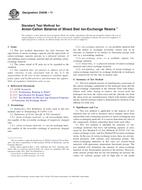Potřebujeme váš souhlas k využití jednotlivých dat, aby se vám mimo jiné mohly ukazovat informace týkající se vašich zájmů. Souhlas udělíte kliknutím na tlačítko „OK“.
ASTM D4548-11
Standard Test Method for Anion-Cation Balance of Mixed Bed Ion-Exchange Resins
Automaticky přeložený název:
Standardní zkušební metoda pro anionty kationtů bilance směsném loži iontoměničové pryskyřice
NORMA vydána dne 1.5.2011
Informace o normě:
Označení normy: ASTM D4548-11
Poznámka: NEPLATNÁ
Datum vydání normy: 1.5.2011
Kód zboží: NS-27665
Počet stran: 4
Přibližná hmotnost: 12 g (0.03 liber)
Země: Americká technická norma
Kategorie: Technické normy ASTM
Kategorie - podobné normy:
Anotace textu normy ASTM D4548-11 :
Keywords:
anion-cation balance, ion exchange, mixed bed, ICS Number Code 71.100.40 (Surface active agents)
Doplňující informace
| Significance and Use | ||||||
|
This test method is applicable to the analysis of new materials that are sold as mixtures and to samples taken from regenerable units containing mixtures of anion-exchanging and cation-exchanging materials. It is used to determine the ratio of the components without separating them from each other. This test method is intended for mixtures of ion-exchange materials that have salt-splitting capacity as measured by Test Method E of Test Methods D 2187 for cation-exchange resins, and Test Method H for anion-exchange resins. In the case of cation-exchange resins, these are styrene-based polymers with sulfonic acid functional groups. The anion-exchanging materials in this class are styrene-based materials with quaternary ammonium functional groups. The test method will determine the amount of anion-exchange material of any functionality present in the mixture. However, when anionic groups that are not salt-splitting are present, the values for cationic groups will be high due to the acidic character of the anion effluent. Cationic groups that do not split salts are not measured. Samples are analyzed in this test method as received. It is not necessary that the cation-exchanging resin be in the hydrogen form and the anion-exchanging resin be in the hydroxide form for this test method. This test method may be used to determine if new materials are balanced to meet their specification values. In operating regenerable units, it may be used to determine if the components are separating properly or remixing properly. It may also be used to check for improper balance in bedding or for loss of a component during operation. This test method begins with the conversion to the hydrogen and chloride forms. However, it may be combined with the determination of the residual chloride and sulfate sites by elution with sodium nitrate as described in Test Methods J and L in Test Methods D 2187. In such cases the hydrogen ion as well as the chloride ion is determined in the second sodium nitrate elution described in Test Method I of Test Methods D 2187, and the calculations given herein are made using the titration values so determined. |
||||||
| 1. Scope | ||||||
|
1.1 This test method determines the ratio between the equivalents of anion-exchange capacity and the equivalents of cation-exchange capacity present in a physical mixture of salt-splitting anion-exchange material and salt-splitting cation-exchange material. 1.2 The values stated in SI units are to be regarded as the standard. 1.3 This standard does not purport to address all of the safety concerns, if any, associated with its use. It is the responsibility of the user of this standard to establish appropriate safety and health practices and determine the applicability of regulatory limitations prior to use. |
||||||
| 2. Referenced Documents | ||||||
|




 Cookies
Cookies
